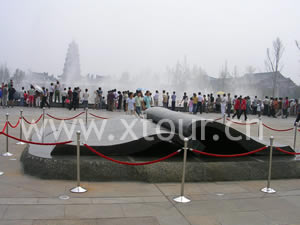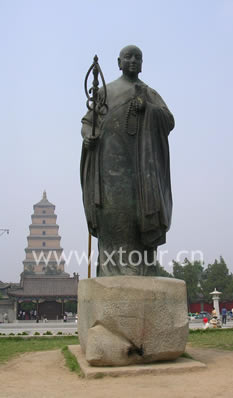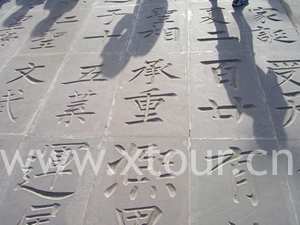
Situated in the Da Ci'en Temple, about four kilometres from
the urban center, the Big Wild Goose Pagoda (also called the Da
Ci'en Temple Pagoda) is one of the famous Buddhist pagodas in
China.
Originally built in 589A. D. in the Sui Dynasty, the temple
was named Wu Lou Si Temple. It was not until 648 A. D. , when
Emperor Li Zhi, then still a crown prince, sponsored a repair pro-
ject on the temple. This was a symbol of thanksgiving to his mother
for her kindness, after she had suffered an early death. The temple
then assumed the present name Da Ci'en Si (Temple of Thanksgiv-
ing). The Emperor was said to pay homage to the temple twice a
day (in the morning and at dusk) by looking in its direction from
the Hanyuan Palace. The temple, with 13 separate courtyards,contained 1, 879 magnificent looking rooms altogether and was a place of grand extent in the Tang Dynasty. However, it went into
gradual decay after the Tang Dynasty. The halls and rooms that
have survived the ages are structures that built in the Ming Dy-
nasty.
The Tang Regime gave orders to build a chamber for the trans-
lation of Buddhist scriptures in an effort to have the then widely
renowned Master Xuan Zang (Monk Tripitaka) agree to be the
head of the temple.
 Xuan Zang was both a great translator and traveller. At the
age of 28 in 627 A. D. , he went alone to India to study Buddhist
scriptures. He stayed there for 17 years, doing research into Bud-
dhism in various places. He returned to Chang'an in 645 A. D.
with 657 volumes of Buddhist scriptures, travelling 50,000 kilome-
tres and suffering many hardships. His Travels in the Western Re-
gions was based on what he had witnessed in the 128 countries and
regions that he visited. He recorded their geographic locations and
customs. This work has become an important 'reference for the
studies of the history and geograghy of these regions. A famous
novelist in the Ming Dynasty even wrote a novel which was set a-
gainst the story of Xuan Zang's western journey for the Buddhist
scriptures. The book became one of the four most famous novels in
the history of Chinese literature. Xuan Zang also translated one of
the Chinese classics Lao Zi into Sanskrit to be introduced into India.
He was indeed a great contributor to the Buddhist cultural ex-
changes between India and China in ancient times. Xuan Zang was both a great translator and traveller. At the
age of 28 in 627 A. D. , he went alone to India to study Buddhist
scriptures. He stayed there for 17 years, doing research into Bud-
dhism in various places. He returned to Chang'an in 645 A. D.
with 657 volumes of Buddhist scriptures, travelling 50,000 kilome-
tres and suffering many hardships. His Travels in the Western Re-
gions was based on what he had witnessed in the 128 countries and
regions that he visited. He recorded their geographic locations and
customs. This work has become an important 'reference for the
studies of the history and geograghy of these regions. A famous
novelist in the Ming Dynasty even wrote a novel which was set a-
gainst the story of Xuan Zang's western journey for the Buddhist
scriptures. The book became one of the four most famous novels in
the history of Chinese literature. Xuan Zang also translated one of
the Chinese classics Lao Zi into Sanskrit to be introduced into India.
He was indeed a great contributor to the Buddhist cultural ex-
changes between India and China in ancient times.
On the day Xuan Zang moved into the temple, the Imperial
Court held a ceremony of unprecedented grandeur for him. The
procession consisted of 1,500 decorated chariots. On the same day,
all the monks from the capital, holding bunches of flowers and in-
cense burners in their hands, followed the procession while reciting
passages from Buddhist scriptures. Escorting the master were civil
and military officials and the Emperor's squad of bodyguards from
the Court. Even the Emperor himself brought the whole royal fami-
ly to the city gate tower. They burnt incense sticks and watched re-
spectfully from there. Later the Emperor selected hundreds of
renowned scholars and Buddhist monks to help Xuan Zang in his
endeavor to translate the Buddhist scriptures that he had brought
back.
¦ Xuan Zang stayed in the temple for 12 years and translated 1,
335 volumes of Buddhist scriptures. In praise of the Master's dedi-
cation to Buddhism, Emperor Tai Zong wrote An Introduction to
the Sacred Teachings of Monk Tripitaka of the Great Tang Dynasty, followed by Crown Prince Li Zhi's Notes on 'An Introduction to the Sacred Teachings of Monk Tripitaka of the Great Tang Dynasty. Chu Suiliang, a famous calligraphist of the Tang Dynastycarved inscriptions on two stone tablets that still can be seen at the
base, on either side of the pagoda.
 In 652 A.D. Xuan Zang made a proposal to the court for a pagoda to be built inside the temple, to store the scriptures and statues he had brought back from India. The Emperor not only readily
agreed, but also raised funds by the sale of things left behind by deseased court maids. Xuan Zang was so pleased that he took part in the manual labour. He also designed the pagoda. The two fierce-
looking stone lions before the front gate of the temple stand there as
if they were two sentinels guarding the place. In 652 A.D. Xuan Zang made a proposal to the court for a pagoda to be built inside the temple, to store the scriptures and statues he had brought back from India. The Emperor not only readily
agreed, but also raised funds by the sale of things left behind by deseased court maids. Xuan Zang was so pleased that he took part in the manual labour. He also designed the pagoda. The two fierce-
looking stone lions before the front gate of the temple stand there as
if they were two sentinels guarding the place.
The pagoda was finished in 652 A. D.. Its five storeys are 60
metres in height. The decay of the earth-cored pagoda caused the
new construction of a 10-storey pagoda from 701 to 704. However,
the winds of war, in the years to come, reduced the pagoda almost
to ruins, which in turn resulted in the construction of a 7-storeyed,
64-metre-high structure which we see today.
The storeyed pagoda was an architectural marvel. It was built with layers of bricks but without any cement in between. The Dou Gong (bracket) style in traditional Chinese architecture was also
used in the construction of the pagoda. The seams between each
layer of bricks and the "prisms" on each side of the pagoda are
clearly vislble. The grand body of the pagoda with its solemn ap-
pearance, simple style and high structure, is indeed a good example
of ancient people's wisdom and talent.
Pictures of the Heavenly King and of the Buddha are on the
door frames and horizontal bars on four sides of the pagoda's base.
These stone sculptures display peak workmanship, and show vivid
shapes and smooth lines. They now serve as an important source of
material for the study of painting and sculpture of the Tang Dy-
nasty. Out of these artistic works, the one on the horizontal bar of
the west door is the most precious. It is a rare piece of art, now
used for the study of the Tang architecture.
There is an interesting story about the name of the pagoda. It
was said that Xuan Zang stayed in the Mahayana Temple in India.
There are two major sects of Buddhism in India, the Mahayana and
the Hinayana. The Mahayana believers are vegetarians while those
of the Hinayana are non-vegetarians. Near the temple where Xuan
Zang was staying, there was a Hinayana Temple. One day a monk
was worried about the shortage of meat in his temple. It just so
~ happened that that day happened to be the General Alms Day of the
Buddha. Another monk looked up at the sky and sighed:"He the
Grea't and Merciful Buddha will never forget what day it is today!"
At these words, a flock of wild geese flew over the temple. The
head goose dropped dead to the ground. The monks were all puz-
zled by this, and they concluded that this must be the result of the
Buddha's spirit at work, to provide them with the wild goose. Ever
since then the monks of that temple became vegetarians and began
to believe in Mahayana. They also set up a pagoda at the place
where the wild goose dropped dead, and called it the Wild Goose
Pagoda. The pagoda was modeled after the one in India. It was giv-
en the same name in memory of Xuan Zang in praise of Buddhism.
After about half a century, the pagoda at Jian Fu Temple was
built. The two pagodas faced each other from a distance, but in dif-
ferent styles. Since the one in Jian Fu Temple is smaller than the
Wild Goose Pagoda, people started to call it the Small Wild Goose
Pagoda.
Inside the temple where the pagoda is situated, there are two
small buildings: the one on the east side houses a bell, and the one
on the west side a drum. The bell, an iron cast, from the Ming Dy-
nasty, weighs 15 tons. Together with the drum, the bell was used
to strike time for the monks in the temple.
 Inside the Great Hall of the Buddha in the temple there are
three incarnations of Sakyamuni. The one in the middle is called
Dharmakaya (an embodiment of truth and law), The one on the
west side is called Bao Shen Buddha, and the one on the opposite
side is called Ying Shen Buddha. Sakyamuni was the founder of
Buddhism. He was a prince of the Kingdom of Dapila in India. He
was born in 565 B. C, , and died in 455 B. C, , and was an approxi-
mate contemporary of Confucius of China. Sakyamuni left home in
search of monkhood when he was 99 and achieved his prupose by
the age of 35. He then spent the rest of his life travelling in india
and preaching his principles. The figure on the east side, beside the
three incarnations of the Buddha is Jia Ye, one of the ten great dis-
ciples of Sakyamuni. The one on the other side is Ahnan,
Sakyamuni's cousin. He served Sakyamuni for 25 years as one of
his ten great disciples. Further along both sides are the eighteen
arhats, also Sakyamuni's disciples. Arhats are the highest ideal po-
sition in Hinayana Buddhism. The concept of the arhat is made up
of three parts: (1)Doing away with evil thoughts (greed, anger, id-
iocy, etc. ); (2)Accepting provisions from the people, after going
up all wordly possessions; (3)Being mortal, once dead there is no
way for any resurrection. Inside the Great Hall of the Buddha in the temple there are
three incarnations of Sakyamuni. The one in the middle is called
Dharmakaya (an embodiment of truth and law), The one on the
west side is called Bao Shen Buddha, and the one on the opposite
side is called Ying Shen Buddha. Sakyamuni was the founder of
Buddhism. He was a prince of the Kingdom of Dapila in India. He
was born in 565 B. C, , and died in 455 B. C, , and was an approxi-
mate contemporary of Confucius of China. Sakyamuni left home in
search of monkhood when he was 99 and achieved his prupose by
the age of 35. He then spent the rest of his life travelling in india
and preaching his principles. The figure on the east side, beside the
three incarnations of the Buddha is Jia Ye, one of the ten great dis-
ciples of Sakyamuni. The one on the other side is Ahnan,
Sakyamuni's cousin. He served Sakyamuni for 25 years as one of
his ten great disciples. Further along both sides are the eighteen
arhats, also Sakyamuni's disciples. Arhats are the highest ideal po-
sition in Hinayana Buddhism. The concept of the arhat is made up
of three parts: (1)Doing away with evil thoughts (greed, anger, id-
iocy, etc. ); (2)Accepting provisions from the people, after going
up all wordly possessions; (3)Being mortal, once dead there is no
way for any resurrection.
This is the Doctrine Chamber, in which stands the Amitabha
Buddha. He in charge of the Western Paradise. At the words of the
Amitahha Buddha, one will be guided by him to the Paradise upon
his death. Therefore, the Amitabha Buddha is also called the God
of Guidance. On the wall at the east side of the chamber, there are
three rubbings. The one in the middle is called Xuan Zang Carries
the Scriptures to Chang'an. With the heavy rolls of scriptures on
his back, a pair of straw sandals on his feet, and an oil lamp on top
of the rolls, Xuan Zang looks to be a fearless tracker on his way
back to the capital. Beside Xuan Zang's rubbing, there is one of
Yuan Ce and the other is Kui Ji, two of Xuan Zang's disciples.
Yuan Ce was from Xin Luo (present Korea). Kui Ji was the
nephew of the famous general Wei Chigong of the early Tang Dy-
nasty. It is clearly seen, just from the status of the discples who fol-
lowed him, that Xuan Zang was very renowned during his day.
In the Tang Dynasty, every successful candidate who passed
the imperial examinations would have to climb up the Big Wild
0oose Pagoda wrote poems and inscriptions there. This ritual would
symbolize a soaring career in the future. The famous poet Bai Juyi
wrote: "Here under the Ci'en Pagoda I inscribe my name as the
youngest among the seventeen candidates", revealing his pride and
happiness when he became successful at a very young age. The
fashion of writing poems and leaving inscriptions on the horizontal
bars over different doors and stone frame-works by the successful
candidates of the imperial examinations went on as far as the Ming
Dynasty. These poems and inscriptions have survived till this day as
a fine mirror to the city's past. Now let us do what those successful
candidates did .. climb the pagoda and enjoy the sight of the old capi-
tal. However, the pity is that we cannot inscribe our names and our
poems on the pagoda as those successful people did long ago!
Transport : Bus 5 21 22 23 24 27 30 34 41 44 224 320 400 401 408 501 521 527 601 606 609 610 701 715 travel bus 6 ;
Opening time : Daily 9am to 5pm;
Admission : dayanta 20 daciensi 25 |

